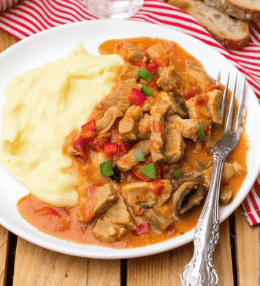
- View
Table of Contents
ToggleAjvar is a Serbian spread that has earned a place at tables across the Balkans. Made primarily from roasted red peppers, it is smooth, vibrant, and packed with flavour. Whether eaten with bread, meat, or cheese, it offers warmth and comfort in every spoonful.
It is often prepared in large batches at the end of summer when peppers are in abundance. Families gather to roast, peel, and stir the mixture, turning a seasonal ritual into both a labour of love and a way to preserve the harvest.
Though humble in appearance, Ajvar carries layers of taste that feel both familiar and distinctive. Its appeal lies in the way it can be served as a simple spread or as part of a larger meal, always bringing depth and richness.
Want to dive deeper into Serbian Cuisine? Don’t miss our post on 20 Traditional Serbian Foods to Try
What Is Ajvar?
Ajvar is a slow cooked spread made from roasted red peppers blended with oil, garlic, and sometimes aubergine. The peppers are first charred until their skins blacken, then peeled and cooked down to create a silky, thick mixture.
It is traditionally served with bread, often still warm from the oven, but it also pairs beautifully with grilled meats or cheeses. Some enjoy it as a dip, while others treat it as a side dish to complement heavier foods.
There are mild and spicy versions, with the heat adjusted by adding chillies. This flexibility makes it a staple that works in many settings, whether it is part of a casual breakfast table or a festive family dinner.
Ingredients and Taste
The foundation of Ajvar is red bell peppers, chosen for their sweetness and colour. Aubergine may be added for depth, while garlic, sunflower oil, vinegar, and salt complete the recipe. Chillies are included when a stronger flavour is desired.
The taste is rich and layered. Roasted peppers bring a natural sweetness, while the long cooking time gives a gentle smokiness. Oil and garlic provide body, and vinegar introduces a subtle tang that lifts the overall flavour.
Texture matters just as much as taste. Some prefer it smooth and creamy, spreadable on fresh bread, while others keep it slightly chunky for a more rustic feel. In every form, it delivers both comfort and freshness.
A Taste of History
Ajvar has roots in Serbian kitchens but quickly spread throughout the Balkans, becoming part of shared culinary identity. Its name is thought to derive from the Turkish word for caviar, hinting at its value as a prized delicacy in earlier times.
Originally, Ajvar was more than a condiment. It was a way to preserve peppers for the colder months, ensuring that families had something nourishing when fresh produce was scarce. Large jars were stored and opened throughout winter.
The practice of preparing Ajvar remains strong, especially in rural areas where families still roast peppers outdoors in late summer. It is both practical and social, turning food preparation into a community event filled with tradition.
Today, Ajvar is enjoyed well beyond Serbia, appearing on tables across Europe and in international shops. It has held onto its roots while finding new admirers, continuing to remind people of how simple ingredients can create something lasting.
How to Make Ajvar (Roasted Red Pepper Spread)
Ajvar is one of Serbia’s most treasured culinary staples, a smoky sweet spread made from roasted red peppers and aubergines, simmered with garlic and oil until silky. Expect a rich depth of flavour, perfect for bread, grilled meats, or as a condiment on the table. The process requires patience but rewards with a jar of warmth and tradition. See the recipe card at the bottom for printable directions
Ingredients
- 2 kg red bell peppers (preferably long, fleshy varieties)
- 2 medium aubergines
- 4 garlic cloves
- 120 ml sunflower oil (traditional, neutral flavour)
- 2 tbsp white wine vinegar
- 1 ½ tsp salt (adjust to taste)
- ½ tsp black pepper
Cooking Instructions
Step 1: Roast the peppers
To begin, preheat your oven to 220°C. Arrange the red peppers on a baking tray in a single layer. Roast for 25–30 minutes, turning occasionally, until skins blister and blacken. Transition to peeling.
Step 2: Steam and peel
Place the hot roasted peppers in a large bowl, cover with a lid or cling film, and let them steam for 15 minutes. This loosens the skin. Peel off the charred skins and remove seeds. Proceed to preparing the aubergines.
Step 3: Roast the aubergines
Pierce the aubergines with a fork and roast alongside the peppers until the skin is charred and the flesh soft, about 30 minutes. Scoop out the flesh and discard the skins. Transition to blending.
Step 4: Blend the vegetables
In a food processor or with a meat grinder (traditional method), blend roasted peppers, aubergine flesh, and garlic until smooth but still slightly textured. Next, move to cooking the spread.
Step 5: Cook down the mixture
Transfer the blended mixture into a wide heavy pot. Cook over medium to low heat, stirring frequently to prevent sticking, for about 60–90 minutes until reduced and thickened. Prepare to add oil and seasoning.
Step 6: Add oil gradually
Slowly drizzle in sunflower oil while stirring continuously. The mixture should absorb the oil and turn glossy. This step builds flavour and preserves the spread. Transition to final seasoning.
Step 7: Season and balance
Stir in vinegar, salt, and black pepper. Adjust to taste. Simmer for another 10 minutes to allow the flavours to meld. Prepare for serving or storing.
Final Step: Serve or preserve
Cool the Ajvar slightly, then transfer into sterilised jars if storing. Serve at room temperature with fresh bread, grilled meats, or cheeses. Presentation tip: a drizzle of extra oil on top preserves freshness and adds sheen.
Variations and substitutions
- Chillies: Add 1–2 hot red chillies for a piquant version known as Ljuti Ajvar.
- Oil: Traditionally sunflower oil is used, but mild olive oil can substitute.
- Aubergine: If unavailable, increase peppers slightly; flavour will be sweeter and less earthy.
- Vinegar: Substitute apple cider vinegar for a softer tang if white wine vinegar is not on hand.
Cooking Tips for Perfect Ajvar
- Choose ripe, fleshy red peppers with firm skins for maximum sweetness.
- Always steam roasted peppers before peeling for easy removal.
- Use a wide pot to speed up evaporation and prevent watery spread.
- Stir frequently during cooking to avoid scorching and achieve a silky texture.
- Store in sterilised jars covered with a thin layer of oil for longer keeping.

Serbian Ajvar (Roasted Red Pepper Spread)
Ingredients
- 2 kg red bell peppers preferably long, fleshy varieties
- 2 medium aubergines
- 4 garlic cloves
- 120 ml sunflower oil traditional, neutral flavour
- 2 tbsp white wine vinegar
- 1 ½ tsp salt adjust to taste
- ½ tsp black pepper
Instructions
- To begin, preheat your oven to 220°C. Arrange the red peppers on a baking tray in a single layer. Roast for 25–30 minutes, turning occasionally, until skins blister and blacken. Transition to peeling.
- Place the hot roasted peppers in a large bowl, cover with a lid or cling film, and let them steam for 15 minutes. This loosens the skin. Peel off the charred skins and remove seeds. Proceed to preparing the aubergines.
- Pierce the aubergines with a fork and roast alongside the peppers until the skin is charred and the flesh soft, about 30 minutes. Scoop out the flesh and discard the skins. Transition to blending.
- In a food processor or with a meat grinder (traditional method), blend roasted peppers, aubergine flesh, and garlic until smooth but still slightly textured. Next, move to cooking the spread.
- Transfer the blended mixture into a wide heavy pot. Cook over medium to low heat, stirring frequently to prevent sticking, for about 60–90 minutes until reduced and thickened. Prepare to add oil and seasoning.
- Slowly drizzle in sunflower oil while stirring continuously. The mixture should absorb the oil and turn glossy. This step builds flavour and preserves the spread. Transition to final seasoning.
- Stir in vinegar, salt, and black pepper. Adjust to taste. Simmer for another 10 minutes to allow the flavours to meld. Prepare for serving or storing.
- Cool the Ajvar slightly, then transfer into sterilised jars if storing. Serve at room temperature with fresh bread, grilled meats, or cheeses. Presentation tip: a drizzle of extra oil on top preserves freshness and adds sheen.
Nutrition
You May Also Like







Leave a Review